#intelarc
Explore tagged Tumblr posts
Text
Dominate the Battlefield: Intel Battlemage GPUs Revealed

Intel Arc GPU
After releasing its first-generation Arc Alchemist GPUs in 2022, Intel now seems to be on a two-year cadence, as seen by the appearance of the Battlemage in a shipping manifest. This suggests that Battlemage GPUs are being supplied to Intel’s partners for testing, as it’s the first time they’ve seen any proof of them existing in the real world. Intel is probably getting ready for a launch later this year given the timing of this.
Two Battlemage GPUs are being shipped by Intel to its partners, per a recently discovered shipment manifest that was published on X. The GPUs’ designations, G10 and G21, suggest Intel is taking a similar approach as Alchemist, offering one SKU that is more or less high-end for “mainstream” gamers and one that is less expensive.
Intel Arc Graphics Cards
As you may remember, Intel had previously announced plans to launch four GPUs in the Alchemist family:
Intel Arc A380
The A380, A580, A750, and A770. However, only the latter two were officially announced. They anticipate that the A750 and A770, which Intel most likely delivers at launch for midrange gamers, will be replaced by the G10.
They’ve never heard of cards being “in the wild,” but two Battlemage GPUs have shown up in the Si Soft benchmark database before. The fact that both of those cards have 12GB of VRAM stood out as particularly noteworthy. This suggests that Intel increased their base-level allowance from 8GB, which is a wise decision in 2024. As stated by Intel’s CEO earlier this year, Battlemage was “in the labs” in January.
Intel Arc A770
A previously released roadmap from Intel indicates that the G10 is a 150W component and the G21 is 225W. It is anticipated that Intel will reveal notable improvements in Battlemage’s AI capabilities, greater upscaling performance, and ray tracing performance. As 225W GPUs were the previous A750 and A770, it seems Battlemage will follow the script when it comes to its efficiency goals. The business has previously declared that it wishes to aim for this “sweet spot” in terms of power consumption, wherein one PCIe power cable is needed rather than two (or three).
While the industry as a whole is anxious to see how competitive Intel will be with its second bite at the apple, gamers aren’t exactly waiting impatiently for Intel to introduce its GPUs like they do with Nvidia or AMD’s next-gen. Even if the company’s Alchemist GPUs were hard to suggest when they first came out, significant performance advancements have been made possible by the company’s drivers.
The Intel Battlemage G10 and G21 next-generation discrete GPUs, which have been observed in shipment manifests, are anticipated to tackle entry into the mid-range market. They already know from the horse’s mouth that Intel is working on its next generation of discrete graphics processors, which it has revealed are being code-named Battlemage. The company is developing at least two graphics processing units, according to shipping excerpts.
Intel Battlemage GPUs
The shipping manifest fragments reveal that Intel is working on several GPUs specifically for the Battlemage G10 and G21 versions. The newest versions in Intel’s graphics processor lineup include the ACM-G11, an entry-level graphics processor, and the ACM-G10, a midrange market positioning and higher-end silicon graphics processor. As a result, the names Battlemage-G10 and Battlemage-G21, which are aimed at entry-level PCs and bigger chips, respectively, match the present names for Intel’s Arc graphics processors. Both stand a strong chance of making their list of the best graphics cards if they deliver acceptable levels of performance.
The Battlemage-G10 and Battlemage-G21 are being shipped for research and development, as stated in the shipping manifest (which makes sense considering these devices’ current status). The G21 GPU is currently in the pre-qualification (pre-QS) stage of semiconductor development; the G10’s current status is unknown.
Pre-qualification silicon is used to assess a chip’s performance, reliability, and functionality. Pre-QS silicon is typically not suitable for mass production. However, if the silicon device is functional and meets the necessary performance, power, and yield requirements, mass production of the device could be feasible. For example, AMD’s Navi 31 GPU, if it meets the developer’s objectives, is mass-produced in its A0 silicon phase.
They rarely get to cover Intel’s developments with its next-generation graphics cards, but they frequently cover Nvidia’s, as they did recently with the GeForce RTX 50-series graphics processors, which should appear on their list of the best graphics cards based on industry leaks.
This generation, Nvidia seems to be leading the laptop discrete GPU market, but Battlemage, with Intel’s ties to OEMs and PC manufacturers, might give the green team some serious competition in the next round. According to the cargo manifest, there will be intense competition among AMD’s RDNA 4, Intel’s Battlemage, and Nvidia’s Blackwell in the forthcoming desktop discrete GPU market.
Qualities:
Targeting Entry-Level and Mid-Range: The ACM-G11 and ACM-G10, the successors to the existing Intel Arc Alchemist series, are probably meant for gamers on a tight budget or seeking good performance in games that aren’t AAA.
Better Architecture: Compared to the Xe-HPG architecture found in Intel’s existing Arc GPUs, readers can anticipate an upgrade in this next-generation design. Better performance per watt and even new features could result from this.
Emphasis on Power Efficiency: These GPUs may place equal emphasis on efficiency and performance because power consumption is a significant element in laptops and tiny form factor PCs.
Potential specifications (derived from the existing Intel Arc lineup and leaks):
Production Process: TSMC 6nm (or, if research continues, a more sophisticated node) Unknown is the core configuration. Possibly less cores than Battlemage models at higher levels (should any exist).
Memory: GDDR6 is most likely used, yet its bandwidth and capacity are unclear. Power Consumption: Designed to use less power than GPUs with higher specifications.
FAQS
What are the Battlemage G10 and G21 GPUs?
Intel is developing the Battlemage G10 and G21, next-generation GPUs that should provide notable gains in capabilities and performance over their predecessors.
What markets or segments are these GPUs targeting?
Targeting a wide range of industries, including professional graphics, gaming, and data centres, the Battlemage G10 and G21 GPUs are expected to meet the demands of both consumers and businesses.
Read more on Govindhtech.com
#Intel#IntelArc#intelarcgpu#govindhtech#INTELARCA380#intelarca770#battlemagegpu#G10#G21#news#technologynews#technology#technologytrends
2 notes
·
View notes
Photo

(via MAXSUN เปิดตัว Intel Arc Pro B60 Dual 48G Turbo การ์ดจอแบบ Dual-GPU ระดับมืออาชีพตอบโจทย์ด้าน AI โดยเฉพาะ)
0 notes
Text
2025-ös Gamer PC-hez ajánlott Videókártyák
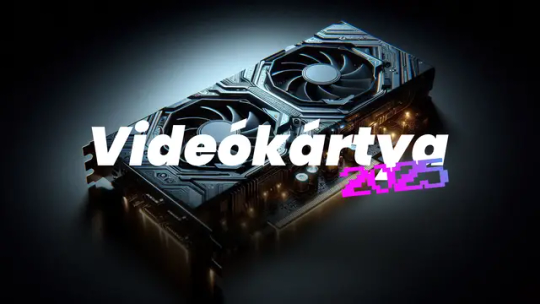
A 2025-ös GPU-piacot a technológiai ugrás és a globális szállítási lánc problémái egyaránt jellemzik
#gamer#gamerslife#gaming#azújgamernemzettevagy#video games#pc games#pc#nvidia#intel#technology#gamervga#videókártya2025#GPU2025#amdradeon#amd radeon#intelarc#raytracing
0 notes
Text
#AAEON#AI#edge computing#IntelArc#GraphicsCard#Innovation#VisualComputing#electronicsnews#technologynews
0 notes
Text
Intel Arc B580 / Intel Arc B570

A Intel anunciou o lançamento de duas novas placas-gráficas da geração "Arc B-Series". As placas B580 e B570 destinam-se ao segmento intermédio e possuem novas tecnologias de processamento gráfico que optimizam o seu uso em contexto profissional e doméstico (incluindo "ray tracing" e inteligência artificial melhorados).
A placa-gráfica Intel B580 inclui 12GB de VRAM dedicada e a placa Intel B570 inclui 10GB de VRAM dedicada, estando estas disponíveis em breve no mercado.
Saiba tudo na página oficial da Intel localizada em: https://www.intel.com/content/www/us/en/newsroom/news/intel-launches-arc-b-series-graphics-cards.html
______ Direitos de imagem: © Intel (via https://www.intel.com/content/www/us/en/newsroom/)
#intel#intelb580#intelb570#intelgraphics#graphics#intelarc#arc#raytracing#frame#resolution#ai#ia#b580#b570#av1#h265#h264#vp9#gpu
1 note
·
View note
Photo
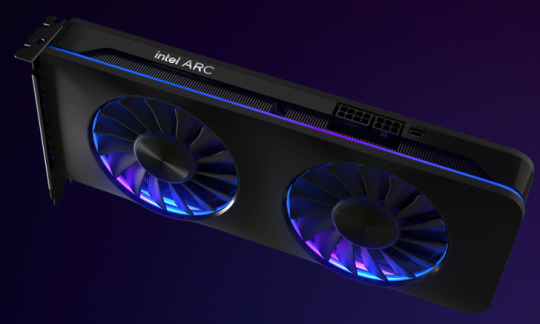
Did you hear about the new Intel Arc Battlemage GPU with PCIe 5.0 x16 interface? This latest tech adds serious power for next-gen gaming and high-performance computing. While Intel just registered a model named "99CMLN" with PCI-SIG, details remain under wraps. But the inclusion of PCIe 5.0 confirms Intel's push for faster data transfer, matching AMD and NVIDIA who already adopted Gen 5.0. This new GPU could be part of Intel’s upcoming Arc Battlemage series, possibly even surpassing current models like the Arc B580. Experts predict it might feature up to 32 Xe2 cores and 16 GB GDDR6 memory—ideal for demanding gamers and creators alike. Stay tuned for more updates, and if you're considering a custom build, check out GroovyComputers.ca for personalized configurations and expert support. Upgrading your setup with the latest tech is easier than you think! What do you think about the move to PCIe 5.0? Would you upgrade your gaming rig now? Let us know in the comments! #TechNews #PCGaming #NextGenGPU #IntelArc #GamingHardware #CustomPC #GPUUpgrade #GamingTech #PerformanceBoost #GroovyComputers #HighPerformance #TechInnovation
0 notes
Text
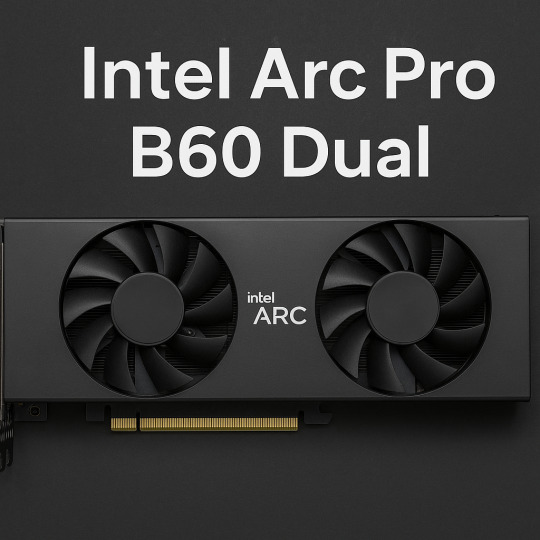
Intel Arc Pro B60 Dual — 48 ГБ памяти за $1000. Настоящий удар по Nvidia?
На выставке Computex 2025 компания Maxsun представила уникальную видеокарту — Intel Arc Pro B60 Dual GPU.
💡 Внутри — сразу две графических чипа, каждый с 24 ГБ GDDR6. Общий объём — 48 ГБ памяти. Карта использует blower-охлаждение и потребляет 240–300 Вт на чип, что делает её удобной для профессиональных рабочих станций и задач, связанных с AI, рендером и виртуализацией.
💰 Самое интересное — цена: около $1000. Это в 5 раз дешевле, чем у аналогичной Nvidia RTX 6000 Ada. Да, у Intel пока есть слабые места в драйверах, но с такими решениями компания уверенно сокращает отставание и предлагает интересную альтернативу.
👉 Полный обзор читай на ByteBoost: 🔗 https://byteboost.art/intel-arc-pro-b60-dual-48gb/
🔗 Pinterest #1: https://pl.pinterest.com/artemheyshchenko/ 🔗 Pinterest #2: https://pl.pinterest.com/asusforyou2/
IntelArc #Maxsun #GPU #Видеокарта #TechNews #Computex2025 #IntelVsNvidia #Workstation #AIgraphics #ByteBoost
0 notes
Text
Likely in response to the very popular #IntelARC #B580 video cards being priced at $250, #Nvidia has announced the first four #RTX5000 cards, including the #RTX5070 priced at $550. Nvidia even claims that it’s as powerful as the previous #RTX4090. Highly unlikely. #CES2025 #tech www.theverge.com/2025/1/6/…
0 notes
Text
Beelink Sei14 Mini PC Review as a Home Lab Server with Intel Arc
Beelink Sei14 Mini PC Review as a Home Lab Server with Intel Arc @vexpert #vmwarecommunities #homelab #homeserver #beelinksei14 #beelinkminipc #intelarcgraphics #intelarc #virtualization #proxmoxve #vmwarevsphere
Beelink kindly sent over a Beelink Sei14 Mini PC for me to review. Of course I do reviews a little bit differently than most when it comes to Mini PCs. The first thing I do is take out the NVMe drive with Windows 11 on it, and load up my favorite hypervisors. This is way more fun. These little mini PCs are also a great way to run a home lab as they are much more efficient and very powerful…
0 notes
Text
Intel Arc A770 GPU: The Ultimate Support For Gameplay

GPU: Intel Arc A770
Intel's entry into discrete graphics cards was widely anticipated. Intel's Arc A770 GPU appeals to gamers and artists seeking value-driven performance. Intel's first Arc Alchemist flagship, the A770, rivals AMD and Nvidia's mainstream products. DirectX 12 Ultimate, AI upscaling, and hardware ray tracing support 1080p and 1440p.
Architecture
The codename Alchemist comes from Intel's Xe-HPG microarchitecture.
Processing node: TSMC N6 (6nm).
GPU ACM-G10 Die.
32 Xe-Core.
Ray-tracing units: 32.
XMX Engines accelerate AI in Xe-Cores.
It uses 512 Vector Engines (FP32 ALUs).
The Intel Arc A770 GPU uses Xe-HPG. This is Intel's first attempt to build a high-performance GPU architecture from scratch, unlike its CPU GPUs.
Key Features
16GB or 8GB GDDR6 VRAM, depending on version.
memory interface 256-bit.
Maximum memory bandwidth: 512 GB/s.
Supports PCIe 4.0 x16.
Full hardware support for 32 RT units.
XeSS (Intel's DLSS competitor) is an AI feature.
Supports HDMI 2.1, DisplayPort 2.0, and four monitors.
AV1 Encoding/Decoding: Hardware-accelerated, future-proof media function.
Unlike older Nvidia and AMD cards, the A770 excels at AV1 encoding and decoding. XeSS also uses AI-powered upscaling to boost frame rates without compromising image quality.
Video Game Performance
Intel Arc A770 GPU competes in 1080p and 1440p:
1080p Ultra Settings: AAA games routinely over 80–100 FPS
High Settings for 1440p: 60–80 fps, depending on game and XeSS usage.
Ray Tracing: Moderate performance with XeSS.
Intel's GPU software has improved over time, therefore driver version may affect performance.
Advantages
High VRAM: The 16GB variant offers more RAM than equivalent Nvidia/AMD GPUs, ideal for future games and developers.
Competitive Pricing: Pitted against the RX 6700 XT and RTX 3060.
Video editors and streams benefit from AV1 encoding.
Intel's AI-powered upscaling is challenged by AMD FSR and Nvidia DLSS.
Full support for high-refresh rate monitors, Vulkan, Ray Tracing, and DirectX 12 Ultimate.
Fast GDDR6 Memory with a Wide Bus: The 256-bit interface optimises memory bandwidth.
Disadvantages
Intel's drivers are less dependable than AMD or Nvidia's, especially in older DX9 or DirectX 11 games, despite improvements.
Good ray tracing but Nvidia RTX in ray-tracing workloads.
Software Ecosystem: Specialised creative apps have limited support.
Power Draw: Outperforms competitors at rest and loaded (225W).
Unreliable Legacy Performance: Outdated APIs can cause unpredictable frame rates.
Efficiency and Power
About 225W TDP.
At least 650W PSU recommended.
One 8-pin and 6-pin PCIe power connector.
Idle power draw is 40W, higher than other efficiency-focused cards.
~200-225W load power draw
Intel Arc A770 GPU makes up for its somewhat worse power efficiency than equivalent Nvidia products with more VRAM and processing units at the pricing.
Memory, bandwidth
VRAM: GDDR6
8GB or 16GB capacity
256-bit memory port
Max bandwidth: 512 GB/s
A770 16GB gives a sustained advantage in memory-intensive tasks like 4K texturing, massive frame buffers, and creative workloads demanding video and picture processing.
Real-World Applications
Gaming: Smooth 1080p and 1440p gaming with XeSS enabled.
Ideal for video editing and AV1 streaming.
Developer and AI workloads: It supports OpenCL and DirectML but is not industry-standard.
Conclusion
Intel's Arc A770 is a great discrete GPU debut. Despite unable to surpass Nvidia or AMD at the high end, it dominates the midrange. Its 16GB VRAM, modern rendering technologies, and AI upscaling make it a terrific value.
Driver maturity remains an issue, especially for older games. Newer drivers have fixed some issues, and Intel is improving its software stack. If you want an affordable GPU with AV1 and XeSS, the Intel Arc A770 GPU is a good choice.
#IntelArcA770GPU#IntelArcA770#IntelArc#A770GPU#IntelArcA770GPUMemory#IntelArcA770GPUgamingperformance#technology#technews#technologynews#news#govindhtech
0 notes
Photo
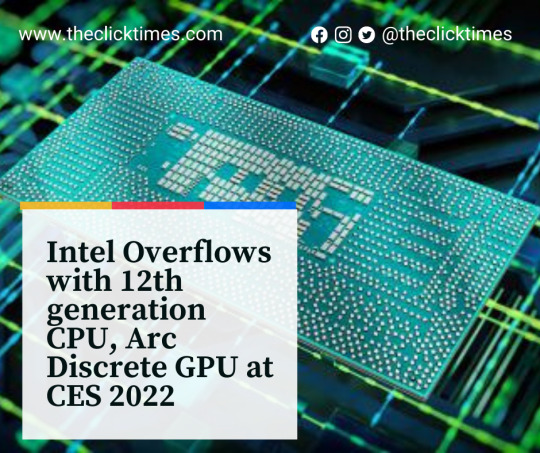
Intel is the youngest of the three major chip-makers to give its keynote address at this year's CES, following previous presentations from rivals AMD and Nvidia. The company's keynote address was given by Gregory Bryant, Executive Vice President and General Manager of Client Computing Group, along with Mobileye Senior Lecturer Amnon Shashua.
"It starts with a spark that creates momentum," noted Intel of its technology at the start of the Altogether Wonderful presentation at CES 2022. Bryant started Intel's Altogether Wonderful presentation at CES earlier this year, based in Las Vegas streamed remotely.
"This acceleration has been driven by the four technology superpowers: Ubiquitous Computing, Cloud Edge Infrastructure, Pervasive Conductivity and A.I," Bryant said .“Each of these technologies are powerful on their own right, but together they reinforce and reinforce each other".
-
Follow us for more updates @theclicktimes
1 note
·
View note
Text
Intel 'Alder Lake' 12th Gen Core, 'Alchemist' GPU Architectures Detailed

Intel held a virtual Architecture Day presentation, disclosing details of the engineering behind several upcoming products in the consumer and data centre spaces. While exact specifications of CPUs and GPUs will have to wait till they are actually launched, we now have a better idea of the building blocks that Intel is using to put them together. Intel SVP and GM of the Accelerated Computing Systems and Graphics group, Raja Koduri, led the presentation during when multiple senior Intel engineers appeared. The 12th Gen Core CPU lineup, codenamed ‘Alder Lake', is expected to launch within the next few months, starting with desktop models. These will be the first mainstream Intel CPUs to feature a mix of high-performance and low-power cores – which is common across mobile SoCs today. This follows the experimental ‘Lakefield' CPU which has had only a limited release so far. Alder Lake will use a more modular approach than before, with different combinations of logic blocks for different product segments. Intel will use the terms Performance core and Efficient core, often shortened to P core and E core. For Alder Lake, the E cores are based on the ‘Gracemont' architecture while the P cores use the ‘Golden Cove' design. For Gracemont, Intel targeted physical silicon size and throughput efficiency, to target multi-threaded performance across a large number of individual cores. These cores run at low voltage and will be used primarily by simpler processes. The Golden Cove-based P cores are designed for speed and low latency. Intel calls this the highest-performing core it has ever built. New with this generation is support for Advanced Matrix Extensions for accelerating deep learning training and inference. Three different Alder Lake dies will serve different product segments Combined, this generation of P and E cores in the Alder Lake architecture will be highly scalable, from 9W to 125W, which covers most of today's mobile and desktop categories. It will be manufactured using the newly announced Intel 7 process, which is a rebranding of the 10nm ‘Enhanced SuperFIN' process. Different implementations will integrate different combinations of DDR5, PCIe Gen5, Thunderbolt 4, and Wi-Fi 6E. The desktop implementation will use a new LGA1700 socket with up to eight performance cores (two threads each), eight efficient cores (single-threaded), and 30MB of last-level cache memory. The integrated GPU will have up to 32 execution units for basic display output and graphics capabilities. It will not have integrated Thunderbolt or an image processing block, but it will support 16 lanes of PCIe Gen5 plus another four lanes of PCIe Gen4. The matching platform controllers for motherboards will have up to 12 more PCIe Gen4 and 16 PCIe Gen3 lanes. Two mobile versions of Alder Lake were also discussed – a more mainstream die with six P cores and eight E cores, and an ultracompact die with two P cores and eight E cores. Both will have GPUs with 96 execution units as well as image processing units and integrated Thunderbolt controllers, and will be aimed at devices that won't have discrete GPUs. All Alder Lake CPUs are comprised of modular logic blocks – the CPU cores, GPU, memory controller, IO, and more. They will support up to DDR5-4800, LPDDR5-5200, DDR4-3200 and LPDDR4X-4266 RAM, and it will be up to motherboard and laptop OEMs to decide which to implement. The modular blocks of each CPU will be connected through three fabrics – Compute, Memory, and IO. Intel describes 100GBps of compute fabric bandwidth per P core or per cluster of four E cores, for a total of 1000GBps between 10 such units. Last-level cache can be dynamically adjusted between inclusive and exclusive depending on load.

Thread Director requires Windows 11 for optimum utilisation of all cores We now have a bit of information about how workloads will be balanced between P and E cores. Intel is announcing a new hardware scheduler called Thread Director, which will be completely transparent to software and will work with the OS scheduler to assign threads to different cores based on urgency and real-time conditions. Designed to scale across mobile and desktop CPUs, Thread Director will be able to adapt to thermal and power conditions and migrate threads from one type of core to another, as well as manage multi-threading on the P cores, with “nanosecond precision”. Thread Director requires Windows 11, and so Alder Lake will perform optimally under this upcoming OS, though Windows 10, Linux, and other OSes will also work. It means that the OS scheduler now understands what kinds of threads require what kinds of resources, and can prioritise latency, power saving, or other parameters depending on operating conditions. Intel has been teasing its first high-end gaming GPU for a while now, and is ramping up hype with the recent announcement of a new Intel Arc brand for GPU hardware, software and services. The first-generation product is codenamed ‘Alchemist', and will launch in early 2022. This is a tier of the Xe architecture product stack known as Xe-HPG, or High Performance Gaming. Alchemist will be manufactured by TSMC on its N6 node. It will support hardware ray tracing as well as DirectX 12 Ultimate features such as mesh shading and variable rate shading.

XeSS will use AI to upscale frames and improve performance, much like DLSS Each first-gen Xe-HPG core will have 16 vector engines and 16 matrix engines plus caches, allowing for common GPU workloads as well as AI acceleration. Four such cores, plus four ray tracing units and other rendering hardware, make up a “slice”. Each Alchemist GPU can have up to eight such slices. Now, we also know that Intel will roll out its own version of AI upscaling, called XeSS (Xe Super Sampling), to take on Nvidia's DLSS and AMD's FSR. XeSS is an AI-based upscaling method that combines information from previous frames. Intel is claiming up to 2X better performance by rendering at lower resolutions and then upscaling to the target resolution. XeSS will run even on Xe LP integrated GPUs, and multiple game developers are on board to support it. While we don't have any GPU specifications yet, Intel did say it has worked on delivering “leadership” performance per Watt. We're sure to find out more as the launch draws nearer. Intel also made several announcements related to its server and datacentre businesses during the Architecture Day, including a demonstration of the upcoming Ponte Vecchio architecture for big data which will be the basis of the Aurora exascale supercomputer. Other highlights were the modular ‘Sapphire Rapids' Xeon Scalable platform, the oneAPI software stack, and an emerging product category – Infrastructure Processing Units (IPUs), designed to separate infrastructure overheads from client data and processing requirements in cloud-centric datacentres. Source link Read the full article
#12th#alchemist#Alder#alderlake#Architectures#Core#Detailed#Gen#GPU#Intel#intelarc#intelarchitecturedayalderlakethreaddirectoralchemistdiscretegpuarchitecturedetailsannouncedintel#Lake#pontevecchio#rajakoduri#sapphirerapids#threaddirector#xe
0 notes
Text
Intel lanza una nueva marca de gráficos de alto rendimiento: Intel Arc
Intel lanza una nueva marca de gráficos de alto rendimiento: Intel Arc #Intel #IntelArc
Intel anunció la marca de sus próximos productos gráficos de alto rendimiento para consumidores: Intel Arc. Intel Arc abarcará el hardware, software y servicios, así como varias generaciones de hardware, con la primera generación, basada en la microarquitectura Xe HPG, cuyo nombre de código es Alchemist (antes conocida como DG2), además Intel también reveló los nombres de código de las futuras…
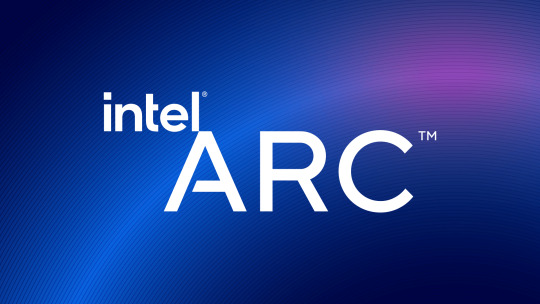
View On WordPress
0 notes
Text
Ryzen 7000X3D Pricing, Arc Updates, The PC is Dead | The complete nerd episode. 246 - PC world
Ryzen 7000X3D Pricing, Arc Updates, The PC is Dead | The complete nerd episode. 246PC world Source link
View On WordPress
#Adam Patrick Murray#alaina yes#amd#amd ryzen 7 7800x3d#AMD Ryzen 9 7900x3d#AMD Ryzen 9 7950x3d#Brad Chaco#calculator#Gordon Mahung#intel#Intel Arc A750#Intelarc a770#news#nvidia#pc#PC building#PC hardware#PC world#podcast#radio#technology#the idiot#writing desk
0 notes
Video
youtube
AMD graphics card launch in October?
0 notes